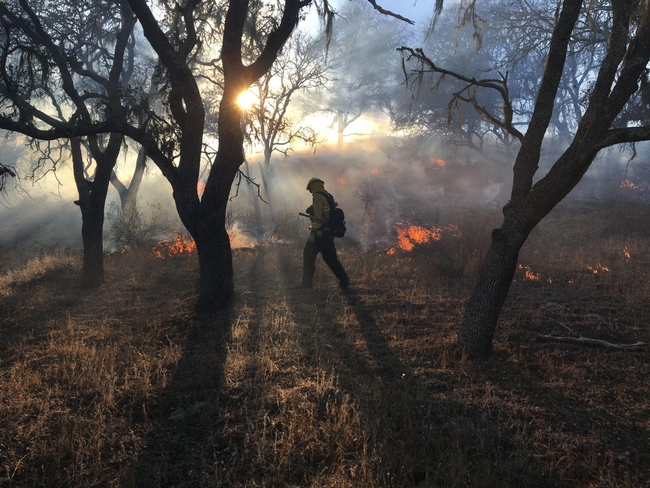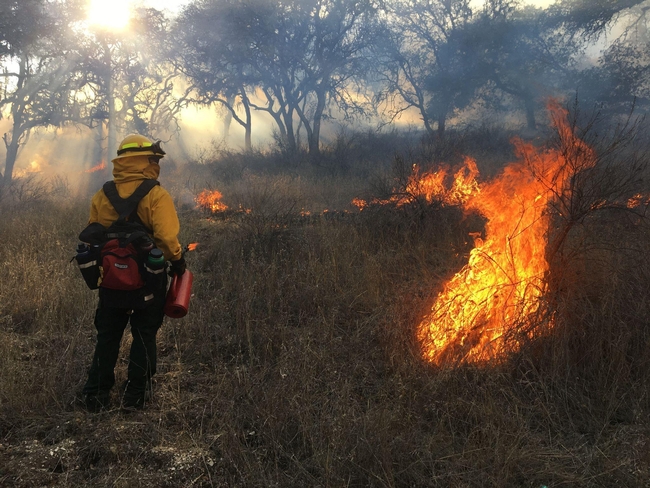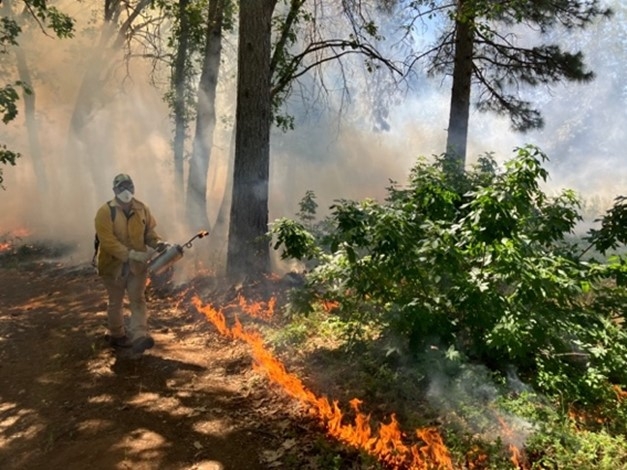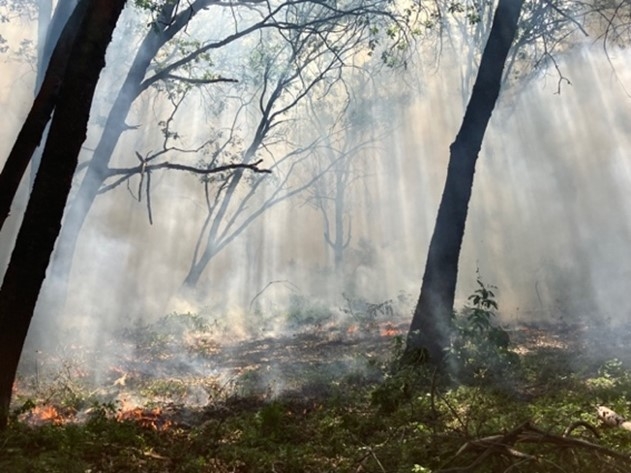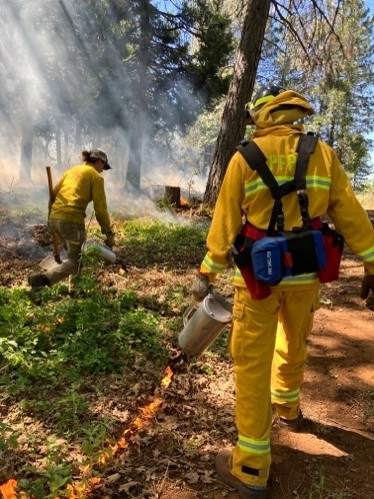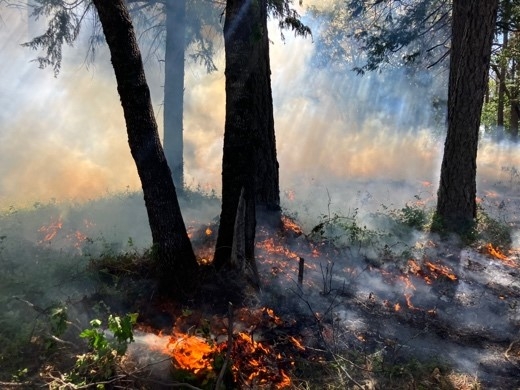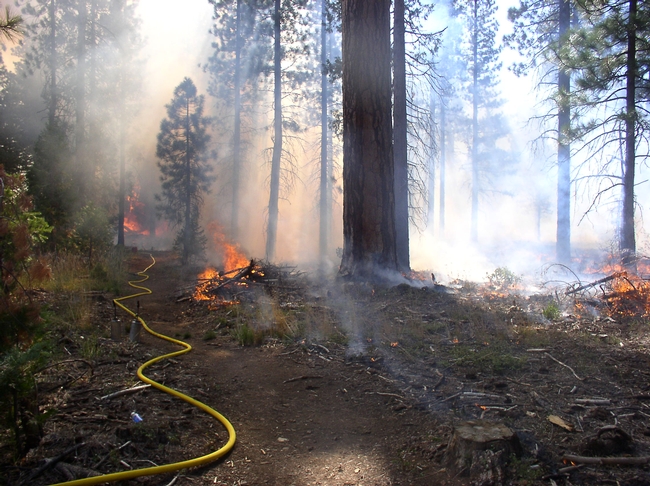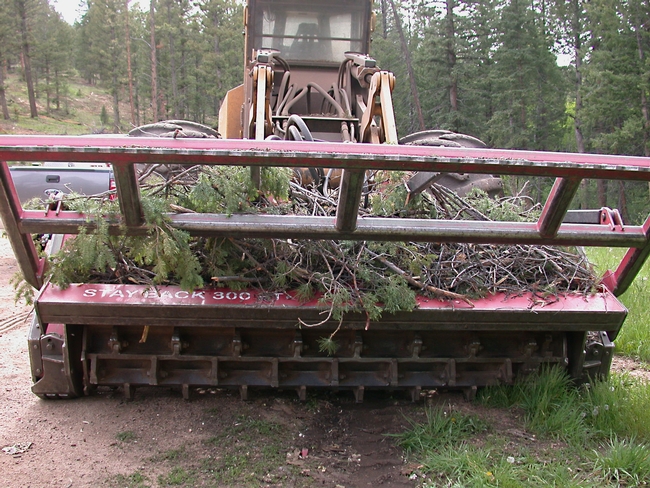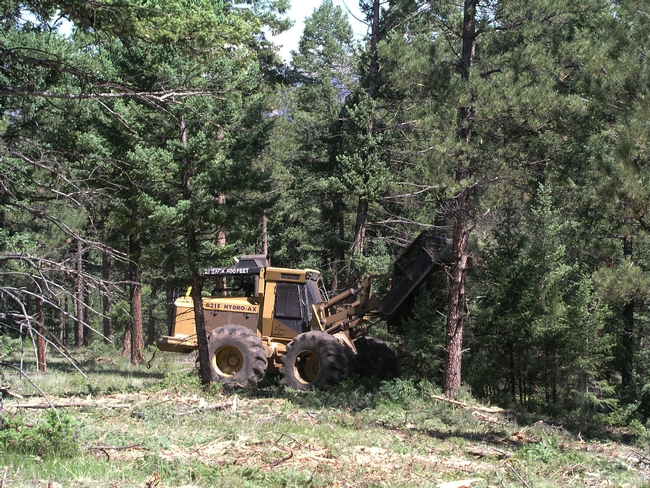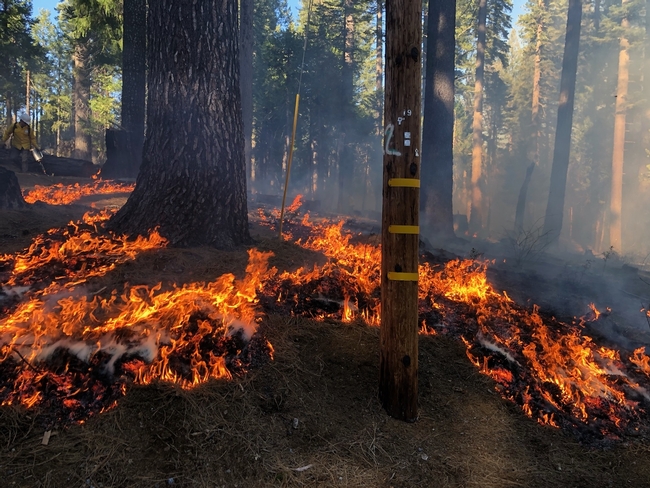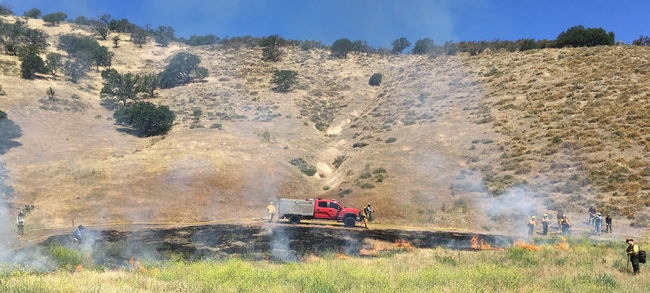Posts Tagged: prescribed burn
Public invited to observe prescribed fire training June 4-9
The Monterey Bay area will host part of the first California Central Coast Prescribed Fire Training Exchange, or Cal-TREX.
Fire practitioners from across the state, greater North America and international locations (Spain, Honduras, Costa Rica, Ecuador) are gathering for a Prescribed Fire Training Exchange on June 3-10.
The training is hosted by the Central Coast Prescribed Burn Association, which empowers the public to build a culture of “good fire” and helps private landowners conduct prescribed burns in Monterey, San Benito and Santa Cruz counties.
Prescribed burns will be open for the public to observe on various days throughout the training, most likely June 4-9, depending on the weather. Please see the CCPBA webpage for updates on upcoming burns: http://calpba.org/centralcoastpba.
Prescribed Fire Training Exchanges (TREX) first came to Northern California in 2013, and have made a dynamic, positive cultural shift concerning prescribed fire, within both regional fire services and the general public. These “good fire” TREX events have drawn significant attention, especially in the context of more severe wildfire seasons.
After months of cross-organizational cooperative planning, participants in the weeklong training will be burning a mix of grassland, oak woodland and shrub vegetation types, and make a lasting, positive change concerning “good fire” on the Central Coast.
The TREX will provide experiential training opportunities to advance regional prescribed fire capacity, while also enhancing research to better understand the ecological response of wild plant and animal species following fire.
At this TREX event, participants will learn how to safely conduct prescribed burns in various vegetation types across three counties. Along with multiple prescribed burns, the weeklong program will include lectures and seminars on local fire ecology of plant and animal species, tribal burning practices and burn planning led by multiple burn bosses and other experts.
Burn locations may include the Nyland property (owned by Trust for Public Land and San Benito Agricultural Land Trust) near San Juan Bautista, the Santa Lucia Conservancy near Carmel Valley and the Kechun Village (owned by the Nason family) in Arroyo Seco.
Be advised, while the CCTREX works closely with the Monterey Bay Air Resources District (MBARD) to assure good smoke dispersal, smoke may be seen and present in these areas during and after a burn. Please see the CCPBA webpage for updates on upcoming burns: http://calpba.org/centralcoastpba.
BurnBot, a new technology featuring a mobile burn chamber, remote-controlled mastication and fire drone systems, will be used for the prescribed burn on June 4. To observe the Nyland burn on June 4, register at https://bit.ly/CCPBApublicRxfire. Details including time and directions will be emailed to registered participants.
Participants and partners include members of the Amah Mutsun Tribal Band and the Esselen Tribe of Monterey County, University of California Agriculture and Natural Resources, Resource Conservation District of Monterey County, CAL FIRE, local land trusts, scientists, ranchers, students, researchers, land managers and others. The CCPBA is funded by two CAL FIRE wildfire prevention grants.
For more information, contact Jamie Tuitele-Lewis, fire fuel mitigation program and forest health coordinator, at jtlewis@rcdmonterey.org or Barb Satink Wolfson, UC Cooperative Extension area fire advisor, at bsatinkwolfson@ucanr.edu.
New El Dorado/Amador Prescribed Burn Association conducts first private landowner burns
The new El Dorado/Amador Prescribed Burn association, formed in August 2021, has conducted several burns with private landowners and received funding for a part-time coordinator.
A new group of local residents dedicated to helping private landowners conduct prescribed burns on their own properties has formed in El Dorado and Amador Counties. The group was convened by Susie Kocher, forestry advisor for the University of California Cooperative Extension in the Central Sierra.
“Prescribed Burn Associations, or PBAs, are groups of landowners helping each other to both learn how to use prescribed fire to manage their properties and to help each other carry it out. They have been common in other states in the Midwest and Southeast United States, but are relatively new to California,” said Kocher. The first PBA was formed in Humboldt County and now there are at least 20 in various stages of development throughout the state.
New El Dorado/Amador PBA holds first burns
To date, the local group has held workshops on prescribed burn use, planning and integration with targeted grazing for fuels reduction. The group held their first broadcast burn on May 15, 2022, at LBS Ranch in Placerville. Due to rain in April, the group was able to take advantage of the tail end of the spring burning window. The event served as an educational opportunity for members to get more live fire experience and discuss the planning and implementation process.
Those who attended were landowners, volunteer fire department members, foresters and community members with varying degrees of experience. Together they reduced fuels and resprouting shrubs by burning an acre of forested land that had previously been thinned and masticated. Fire behavior and effects occurred as planned, with low flame lengths and good consumption of live and dead vegetation.
Funding received for part-time coordinator
In April, the University of California Cooperative Extension was awarded funding through a Regional Forest and Fire Capacity subaward from the Watershed Research and Training Center, by a grant awarded by the California Department of Conservation to hire a part-time PBA coordinator. A total of nine PBAs across the state received subawards to fund leadership, peer mentorship, training and travel. The El Dorado/Amador PBA was awarded funding for a half-time coordinator for the next two years. The new coordinator, Kestrel Grevatt, is based at UC Berkeley's Blodgett Forest Research Station and will be splitting her time between the PBA and her role as intern forester at Blodgett. She has a background in fire suppression, prescribed burning and implementing and overseeing fuels reduction work.
Looking forward, the group is planning a burn plan writing workshop for August. This workshop will be intended to help landowners understand the prescribed fire planning process, necessary burn plan components and help them walk away at the end of the day with a drafted burn plan. Attendees will have the opportunity to download and create maps, plan burn units, discuss permits needed and smoke considerations, and write a weather/fuels prescription, all with guidance from PBA leaders and agency representatives. Through the fall and winter, the group's priorities will be to implement burns and make local and regional training opportunities available to members.
“The overall goal of the group is to give community members the support to safely and effectively put good fire on the ground. By starting small, with a few acres at a time, members can learn how to use this tool and develop comfort with fire as a process. Over time, with many landowners' involvement, we can continue to increase the pace and scale of prescribed fire,” said Grevatt.
For more information, please contact Kestrel Grevatt kestrelgrevatt@berkeley.edu.
The work upon which this publication is based was funded in whole or in part through a Regional Forest and Fire Capacity subaward from the Watershed Research and Training Center, by a grant awarded by the California Department of Conservation. The El Dorado / Amador PBA is also supported by UC ANR.
Proper land management can help forest owners ease wildfire risk following mass tree die-off
The massive die-off of conifers in the Sierra Nevada between 2012 and 2018 was predictable and unprecedented. Sadly, it is also likely to happen again, said UC Cooperative Extension forestry advisor Susie Kocher.
To help landowners manage forests in a way that minimizes the risk of such catastrophic tree die-off and the threat of uncontrolled wildfire, Kocher and two colleagues produced a 20-page publication that summarizes current research on tree mortality and outlines actions that can be taken to make the forest more resilient. The publication, Mass Tree Mortality, Fuels, and Fire: A Guide for Sierra Nevada Forest Landowners, is available for free download from the UC Agriculture and Natural Resources catalog.
Written by Stanford graduate student Devin McMahon (now graduated), UC Berkeley Cooperative Extension forest health specialist Jodi Axelson and Kocher, the publication presents the extent of the die-off in the Sierra Nevada, and describes different factors that contributed to the vast loss of tree life – including land management practices, weather patterns and geography. It includes detailed reporting on the mortality's impacts on fuels and fire risk so landowners and managers can understand and develop strategies to prevent similar destruction in the future.
While about two-thirds of California's 33 million acres of forests are public lands held by state and federal government agencies, the rest is in private hands. Large companies manage millions of acres for commercial timber production, but about 9 million acres are owned by individuals. Nearly 90% of individuals own 50 acres or less; 87,000 landowners have 10 acres or more of forest.
“That's a really large number of people,” Kocher said. “That's one of the reasons why it is so difficult for landowners to manage land to improve forest health and reduce fire risk. It's not economical to do forest management on small areas.”
It's also very complicated. As natural processes play out over time in a forest with mass mortality, the fire risk changes dramatically.
“In the new publication, we help people understand the nuances of forest management so they understand what actions are most appropriate throughout the whole cycle,” she said.
Assessing and addressing the fire risk
The publication provides an overview of fire risk reduction. A table lays out the seven components of fire risk – fuel load, fuel moisture, fuel continuity, probability of ignition, weather conditions, topography and vulnerability to fire – along with mitigation actions for each that landowners can take.
Intentional, controlled burning, or prescribed fire, is often the most effective way to decrease fuel loads and future risk from fires, the researchers wrote. Other management actions include masticating – chewing up brush and branches with specialized equipment – felling and removing dying and dead standing trees, and thinning live trees.
The authors conclude with a glimmer of hope for the future of California forest lands. “Carefully planned forest management can reduce the amount and continuity of fuel on the landscape and limit the risk of destructive fire after tree mortality.”
To reduce wildfire risk, forestland owners can do winter controlled burns, says UCCE expert
When conditions are right, winter can be a good time to conduct prescribed burns for forest management, says Rob York, UC Cooperative Extension forestry specialist.
“A huge issue we have in California is fire severity. We know from research that prescribed fire can be a very good tool for reducing fire severity,” York said. “For forest landowners or foresters who want to do their own prescribed burning, winter burning can be a good entry point.”
York is based at the UC Blodgett Forest Research Station in Georgetown, where he developed a series of eight short videos demonstrating how fire can be used on landscapes during the colder months. The videos feature controlled fires conducted at the station on Dec. 6 and 9, 2020. More videos in this series will be posted during the upcoming year.
Among the factors covered in the videos are climatic conditions and site selection for winter burning.
Climatic conditions
Wet or snowy weather in the fall may seem to shut the window for prescribed burning, but York said often the snow melts away and fuels dry out enough to do a winter burn.
“The idea is to be ready when the fuels dry out,” he said. Thinning trees and masticating underbrush are ways to prepare the forest for a burn.
When selecting the day of the fire, relative humidity, temperature and wind speed and direction are important considerations.
“Relative humidity should be low. You want the cloud cover to be very low. A sunny day helps dry out the fuel,” York said. “In the winter, you want that drying and heating power of the sun to help the fuel be consumed.”
Site selection
Among the factors to consider in selecting locations for winter burns is the aspect. The sun's warmth is optimized on south-facing slopes.
“That's what we're looking for,” York said. “Relatively small areas that are burnable.”
An open canopy allows sunlight to dry out the understory vegetation and surface fuels, enabling successful winter burns.
Vegetation type also weighs into winter burning decisions.
“Bear clover plus pine needles make this feasible, including conditions on the wetter side when you might not otherwise be able to burn, you can burn,” York said. “If you can encourage bear clover and pine needles, you can encourage more opportunities for low density burns, which I think do a great job to maintain low fire hazard.”
Find the complete series on the UC Forestry and Range YouTube channel (https://www.youtube.com/user/UCExtensionForestry) in the playlist titled Winter Prescribed Burning.
UC Agriculture and Natural Resources brings the power of UC to all 58 counties. Through research and Cooperative Extension in agriculture, natural resources, nutrition, economic and youth development, our mission is to improve the lives of all Californians. Learn more at ucanr.edu.
UCCE leads development of prescribed burn association in San Benito, Monterey and Santa Cruz counties
With a $379,785 grant from CAL FIRE, UC Cooperative Extension and the Resource Conservation District of Monterey County are spearheading a community effort to create a prescribed burn association along California's Central Coast region.
The grant is one of 55 awarded by CAL FIRE to reduce the risk of devastating wildfires that take lives and destroy homes and valued wildland environments across California.
“These 55 local projects will play a critical role in augmenting our fire prevention efforts,” said CAL FIRE director Chief Thom Porter.
Prescribed burn associations (PBAs) are made up of ranchers, volunteer firefighters, non-profit organization and other community members. They pool their resources and energy to plan and conduct prescribed burns on private land. The first California PBA was established in 2018.
“Improving forage and reducing fire risk are key goals of our prescribed burns,” said Devii Rao, UC Cooperative Extension natural resources advisor and project manager. “We will also plan fires to control non-native invasive weeds and restore and enhance wildlife habitat.”
Funds for the CAL FIRE grant program are part of the California Climate Investment, a statewide program that uses cap-and-trade dollars to reduce greenhouse gas emissions, strengthen the economy, improve public health and conserve the environment. While prescribed burns emit smoke and carbon dioxide, the amount is much lower than high-intensity wildfires.
Rao said UCCE will be holding workshops and meetings to teach potential association members and the general public about fire ecology, fire permitting, prescribed burn planning and liability associated with burning.
“People are really seeing the value of prescribed fire and they are seeing that it's better to have several smaller burns throughout the year as opposed to these giant, catastrophic wildfires that cause so much damage,” Rao said. “If we can have many smaller burns, we can achieve resource conservation goals, we can achieve forage improvement goals and we can improve fire safety all at the same time.”
Grazing cattle for fire safety
Rao is also leading a study, funded by the California Cattle Council, to better understand the influence of livestock grazing on fire safety of California wildlands. This project is in collaboration with UCCE rangeland specialist Luke Macaulay, UCCE livestock and natural resources advisor Sheila Barry, rangeland consultant Felix Ratcliff and recent UC Berkeley graduate Rowan Peterson.
The researchers used brand inspection data, USDA Ag Census data and county crop reports to estimate the number of rangeland cattle in each county across the state. They estimated how much forage – or from the fire safety perspective, how much fuel – the cattle are consuming.
“Thanks to Felix's great work analyzing these multiple complex datasets, our preliminary results show that cattle consumed approximately 12.4 billion pounds of forage across California in 2017,” Rao said.
Tulare County had the greatest amount of wildfire fuel consumed (1.3 billion pounds), and Orange County had the least (896,000 pounds). Forage removed per grazed rangeland acre ranged from a low of 13 pounds per acre in Alpine County to 2,157 pounds per acre in Tulare County.
Counties in the San Francisco Bay Area, the Sacramento and San Joaquin Valleys, the Sierra Nevada Foothills, and the northernmost counties in the state had somewhat higher removal of wildfire fuel per grazed acre compared with other counties in the state.cedx
“Our analysis is currently ongoing. However, this preliminary analysis shows that many counties have adequate rangeland grazing to significantly reduce wildfire risk, at least in certain strategic areas,” Rao said.
In many counties, grazed rangelands are only a fraction of total grazeable rangeland.
“These counties highlight opportunities for grazing to help fight wildfire risk,” Rao said.


